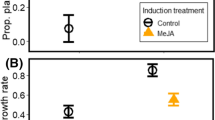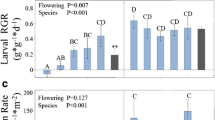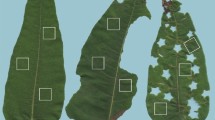Abstract
Although wound-induced responses in plants are widespread, neither the ecological nor the evolutionary significance of phytochemical induction is clear. Several studies have shown, for example, that induced responses can act against both plant pathogens and herbivores simultaneously. We present the first evidence that phytochemical induction can inhibit a pathogen of the herbivore responsible for the defoliation. In 1990, we generated leaf damage by enclosing gypsy moth larvae on branches of red oak trees. We then inoculated a second cohort of larvae with a nuclear polyhedrosis virus (LdNPV) on foliage from the damaged branches. Larvae were less susceptible to virus consumed on foliage from branches with increasing levels of defoliation, and with higher concentrations of gallotannin. Defoliation itself was not related to any of our chemistry measures. Field sampling supported the results of our experiments: death from virus among feral larvae collected from unmanipulated trees was also negatively correlated with defoliation. In 1991, defoliation and gallotannin were again found to inhibit the virus. In addition, gallotannin concentrations were found to be positively correlated with defoliation the previous year. Compared with previous results that demonstrated a delecterious effect of induction on gypsy moth pupal weight and fecundity, the inhibition of the virus should confer an advantage to the gypsy moth. Since leaf damage levels increase as gypsy moth density increases, and since leaf damage inhibits the gypsy moth virus, there is the potential for positive feedback in the system. If phytochemical induction in red oak can inhibit an animal pathogen such as LdNPV, it suggests to us that induction in red oak is a generalized response to tissue damage rather than an adaptive defense against herbivores.
Similar content being viewed by others
References
Agrios GN (1988) Plant pathology. Academic Press, New York
Anderson RM, May RM (1980) Intectious diseases and population cycles of forest insects. Science 210:658–661
Baldwin IT, Schultz JC (1983) Rapid changes in tree leaf chemistry induced by damage: evidence for communication between plants. Science 221:277–279
Baltenswelier W, Benz G, Bovey P, Delucchi P (1977) Dynamics of larch bud moth populations. Annu Rev Entomol 22:79–100
Barbosa P, Krischik VA (1988) Influence of alkaloids on feeding preference of eastern deciduous forest trees by the gypsy moth, Lymantria dispar. Am Nat 130:53–69
Bate-Smith EC (1977) Astringent tannins of Acer species. Phytochemistry 16:1421–1426
Bell AA (1981) Biochemical mechanism of disease resistance. Annu Rev of Plant Physiol 32:21–81
Bell AA (1986) Physiology of secondary compounds in cotton. In: Mauney JR, Stewart J McD (eds) Cotton physiology. The Cotton Foundation, Memphis, TN, pp 597–621
Benedict JH, Chang JF (1991) Bacterially induced changes in the cotton plant-boll weevil paradigm. In: Tallamy DW, Raupp MJ (eds) Phytochemical induction by herbivores. John Wiley and Sons, Inc., New York, pp 379–401
Bergelson JM, Lawton JH (1988) Does foliage damage influence predation on the insect herbivores of birch? Ecology 69:434–445
Bergelson JM, Fowler SV, Hartley SE (1986) The effects of foliage damage on casebearing moth larvae, Coleophora serratella, feeding on birch. Ecol Entomol 11:241–250
Bess HA, Spur SH, Littlefield EW (1947) Forest site conditions and the gypsy moth. Harvard Forest Bulletin, vol 22
Braker WL (1981) Soil survey of Centre County, PA. United States Department of Agriculture, Washington, DC
Bryant JP, Chapin FS, Klein DR (1983) Carbon/nutrient balance of boreal plants in relation to vertebrate herbivory. Oikos 40:357–368
Cadman CH (1960) Inhibition of plant virus infection by tannins. In: Pridham JB (ed) Plants in health and disease. Pergamon Press, London, pp 101–105
David WAL, Taylor CE (1977) The effect of sucrose content of diets on susceptibility to granulosis virus disease in Pieris brassicae. J Invert Pathol 30:117–118
Doane CC (1970) Primary pathogens and their role in the development of an epizootic in the gypsy moth. J Invert Pathol 15:21–33
Edwards PJ, Wratten SD (1982) Wound-induced changes in palatibility in birch (Betula pubescens Ehrh. spp. pubescens). Am Nat 120:816–818
Edwards PJ, Wratten SD (1983) Wound-induced defenses in plants and their consequences for patterns in insect grazing. Oecologia 59:88–93
Edwards PJ, Wratten SD (1985) Induced plant defenses against insect grazing: Fact or artefact? Oikos 44:70–74
Edwards PJ, Wratten SD (1987) Ecological significance of wound-induced changes in plant chemistry. In: Labeyrie V, Fabres G, Lachalse D (eds) Insects-Plants. W. Junk, Dordrecht, pp 213–215
Edwards PJ, Wratten SD, Gibberd RM (1991) The impact of inducible phytochemicals on food selection by insect herbivores and its consequences for the distribution of grazing damage. In: Tallamy DW, Raupp MJ (eds) Phytochemical induction by herbivores. John Wiley and Sons, Inc., New York, pp 205–221
Faeth SH (1985) Host leaf selection by leaf miners: Interactions among three trophic levels. Ecology 66:870–875
Faeth SH (1987) Indirect interactions between seasonal herbivores via leaf chemistry and structure. In: Spencer KC (ed) Chemical mediation of coevolution. Academic Press, San Diego, pp 391–414
Faeth SH (1991) Variable induced responses: direct and indirect effects on oak folivores. In: Tallamy DW, Raupp MJ (eds) Phytochemical induction by herbivores. John Wiley and Sons, Inc., New York, pp 293–323
Felton GW, Dahlman DL (1984) Allelochemical induced stress: effects of L-Canavanine on the pathogenicity of Bacillus thuringiensis in Manduca sexta. J Invert Pathol 44:187–191
Felton GW, Duffy SS (1990) Inactivation of baculovirus by quinones formed in insectdamaged plant tissues. J Chem Ecol 16:1221–1236
Felton GW, Duffey SS, Vail PV, Kaya HK, Manning J (1987) Interaction of nuclear polyhedrosis virus with catechols: Potential incompatability for host-plant resistence against noctuid larvae. J Chem Ecol 13:947–957
Foster MA, Schultz JC, Hunter MD (1992) Modeling gyspy moth-virus-leaf chemistry interactions: implications of plant quality for pest and pathogen dynamics. J Anim Ecol 61:509–520
Fowler SV, Lawton JH (1985) Rapidly induced defenses and talking trees: The devil's advocate position. Am Nat 126:181–195
Friend J (1979) Phenolic substances and plant disease. In: Swain T, Harborne JB, Van Sumere CF (eds) Biochemistry of plant phenolics. Plenum Press, New York, pp 557–588
Green TR, Ryan CA (1972) Wound-induced proteinase inhibitor in plant leaves: a possible defence mechanism against insects. Science 175:776–777
Hagerman AE (1987) Radial diffusion method for determining tannin in plant extracts. J Chem Ecol 13:437–449
Hammond AM, Hardy TN (1988) Quality of diseased plants as hosts for insects. In: Heinrichs EA (ed) Plant stress-insect interactions. John Wiley and Sons, Inc., New York, pp 381–432
Harborne JB (1988) Flavonoids in the environment: structure-activity relationships. In: Cody V, Middleton E, Harborne JB, Beretz A (eds) Plant flavonoids in biology and medicine II. AR Liss, New York, pp 17–27
Hare JD (1983) Manipulation of host suitability for herbivore pest management. In: Denno RF, McClure MS (eds) Variable plants and herbivores in natural and managed systems. Academic Press, New York, pp 655–680
Hartley SE, Firn RD (1989) Phenolic biosynthesis, leaf damage, and insect herbivory in birch (Betula pendula). J of Chem Ecol 15:275–283
Hartley SE, Lawton JH (1987) The effects of different types of damage on the chemistry of birch foliage and the responses of birch feeding insects. Oecologia 74:432–437
Hartley SE, Lawton JH (1990) Damage-induced changes in birch foliage: mechanisms and effects on insect herbivores. In: Watt AD, Leather SR, Hunter MD, Kidd NAC (eds) Population dynamics of forest insects. Intercept, Andover, pp 147–155
Haukioja E, Niemela P (1977) Retarded growth of a geometrid larva after mechanical damage to leaves of its host tree. Annal Zool Fenn 14:48–52
Haukioja E, Niemela P (1979) Birch leaves as a resource for herbivores: seasonal occurence of increased resistence in foliage after mechanical damage of adjacent leaves. Oecologia 39:151–159
Haukioja E, Neuvonen S (1985) Induced long-term resistance of birch foliage against defoliators: defensive or incidental? Ecology 66:1303–1308
Haukioja E, Neuvonen S, Hanhimaki S, Niemela P (1988) The autumnal moth in Fennoscandia. In: Berryman AA (ed) Dynamics of forest insect populations: patterns, causes and management strategies. Plenum Press, New York, pp 163–178
Haukioja E, Ruohomaki K, Senn J, Suomela J, Walls M (1990) Consequences of herbivory in the mountain birch (Betula pubescens ssp. tortuosa): Importance of the functional organization of the tree. Oecologia 82:238–247
Hunter MD (1987) Opposing effects of spring defoliation on late season oak caterpillars. Ecol Entomol 12:373–382
Hunter MD (1992a) Interactions within herbivore communities mediated by the host plant: The keystone herbivore concept. In: Hunter MD, Ohgushi T, Price PW (eds) Effects of resource distribution on animal-plant interactions. Academic Press, San Diego, pp 287–325
Hunter MD (1992b) A variable insect-plant interaction: The relationship between tree budburst phenology and population levels of insect herbivores among trees. Ecol Entomol 17:91–95
Inoue KH, Hagerman AE (1988) Determinants of gallotannin with rhodanine. Anal Biochem 169:363–369
Karban R (1987) Environmental conditions affecting the strength of induced resistance against mites in cotton. Oecologia 73:114–419
Karban R (1991) Inducible resistance in agricultural systems. In: Tallamy DW, Raupp MJ (eds) Phytochemical induction by herbivores. John Wiley and Sons, Inc., New York, pp 402–419
Karban R, Myers JH (1989) Induced plant responses to herbivory. Annu Rev Ecol Syst 20:331–348
Karban R, Adamchak R, Schnathorst WC (1987) Induced resistance and interspecific competition between spider mites and a vascular wilt fungus. Science 235:678–679
Keating ST, Yendol WG (1987) Influence of selected host plants on gypsy moth (Lepidoptera: Lymantriidae) larval mortality caused by a baculovirus. Environ Entomol 16:459–462
Keating ST, Yendol WG, Schultz JC (1988) Host plant dependent differences in the susceptibility of gypsy moth larvae (Lepidoptera: Lymantriidae) to a Baculovirus as possibly influenced by foliage chemistry. Environ Entomol 17:952–958
Keating ST, McCarthy WJ, Yendol WG (1989) Gypsy moth (Lymaantria dispar) larval susceptibility to a baculovirus affected by selected nutrients, hydrogen ions (pH) and plant allelochemicals in artificial diets. J Invert Pathol 54:165–174
Keating ST, Hunter MD, Schultz JC (1990) Leaf phenolic inhibition of the gypsy moth nuclear polyhedrosis virus: the role of polyhedral inclusion body aggregation. J Chem Ecol 16:1445–1457
Kleiner KW (1991) Stability of phenolic and protein measures in excised oak foliage. J Chem Ecol 17:1243–1251
Kleiner KW, Montgomery ME, Schultz JC (1989) Variation in leaf quality of two oak species: implications for stand susceptibility to gypsy moth defoliation. Can J For Res 19:1445–1450
Kuc J (1981) Multiple mechanisims, reaction rates, and induced resistance in plants. In: Staples RC (ed) Disease control. John Wiley and Sons, Inc., New York, pp 259–272
Kuc J (1987) Plant immunization and its applicability for disease control. In: Chet I (ed) Approaches to plant disease control. John Wiley and Sons, Inc., New York, pp 255–274
Magnoler A (1974) Bioassay of a nucleopolyhedrosis virus of the gypsy moth, Porthetria dispar. J Invert Pathol 23:190–196
McIntyre JL, Dodds JA, Hare JD (1981) Effects of localized infection of Nictinia tabacum by tobacco mosaic virus on systemic resistance against diverse pathogens and an insect. Phytopathology 71:297–301
Murray KD, Elkinton JS (1989) Environmental contamination of egg masses as a major component of transgenerational transmission of gypsy moth nuclear polyhedrosis virus (LDNPV). J Invert Pathol 53:324–334
Price PW, Bouton CE, Gross P, McPheron BA, Thompson JN, Weis AE (1980) Interactions among three trophic levels: influence of plants on interactions between insect herbivores and natural enemies. Annu Rev Ecol Syst 11:41–65
Raupp MJ, Denno RF (1984) The suitability of damaged willow leaves as food for the leaf beetle, Plagiodera versicolora. Ecol Entomol 9:443–448
Raupp MJ, Sadof CS (1991) Responses of leaf beetles to injuryrelated changes in their salicaceous hosts. In: Tallamy DW, Raupp MJ (eds) Phytochemical induction by herbivores. John Wiley and Sons, Inc., New York, pp 183–203
Renaud PE, Hay ME, Schmitt TM (1990) Interactions of plant stress and herbivory: Intraspecific variation in the susceptibility of a palatable versus an unpalatable seaweed to sea urchin grazing. Oecologia 82:217–226
Rossiter MC, Schultz JC, Baldwin IT (1988) Relationships among defoliation, red oak phenolics and gypsy moth growth and reproduction. Ecology 69:267–277
SAS Institute Inc (1985) SAS User's Guide: Statistics. Cary, NC
Schultz JC (1988) Plant responses induced by herbivores. TREE 3:45–49
Schultz JC, Baldwin IT (1982) Oak leaf quality declines in response to defoliation by gypsy moth larvae. Science 217:149–151
Schultz JC, Foster MA, Montgomery ME (1990) Host plant-mediated impacts of a baculovirus on gypsy moth populations. In: Watt AD, Leather SR, Hunter MD, Kidd NAC (eds) Population dynamics of forest insects. Intercept, Andover, pp 303–313
Schultz JC, Hunter MD, Appel HM (1992) Antimicrobial activity of polyphenols mediates plant-herbivore interactions. In: Hemingway RW, Laks PE (eds) Plant polyphenols: biogenesis, chemical properties, and significance. Plenum Press, New York, pp 621–637
Tallamy DW, Raupp MJ (1991) Phytochemical induction by herbivores. John Wiley and Sons, Inc., New York
Turchin P (1990) Rarity of density dependence or population regulation with lags? Nature 344:660–663
Wallner WE, McManus ML (1981) Population dynamics; historical review. USDA Technical Bulletin 1584:202–203
Wallner WE, Walton GS (1979) Host defoliation: a possible determinant of gypsy moth population quality. Ann Entomol Soc America 72:62–67
Woods SA, Elkinton JS (1987) Bimodal patterns of mortality from nuclear polyhedrosis virus in gypsy moth (Lymantria dispar) populations. J Invert Pathol 50:151–157
Woods SA, Elkinton JS, Podgwaite JD (1989) Acquisition of nuclear polyhedrosis virus from tree stems by newly emerged gypsy moth (Lepidoptera: Lymantriidae) larvae. Environ Entomol 18:298–301
Wratten SD, Edwards PJ, Barker AM (1990) Consequences of rapid feeding-induced changes in trees for the plant and the insect: individuals and populations. In: Watt AD, Leather SR, Hunter MD, Kidd NAC (eds) Population dynamics of forest insects. Intercept, Andover, pp 137–145
Author information
Authors and Affiliations
Rights and permissions
About this article
Cite this article
Hunter, M.D., Schultz, J.C. Induced plant defenses breached? Phytochemical induction protects an herbivore from disease. Oecologia 94, 195–203 (1993). https://doi.org/10.1007/BF00341317
Received:
Accepted:
Issue Date:
DOI: https://doi.org/10.1007/BF00341317




